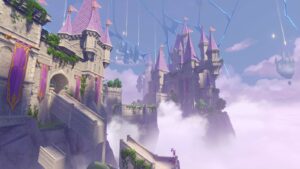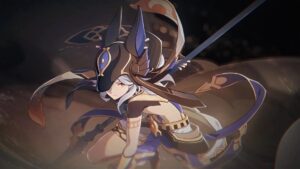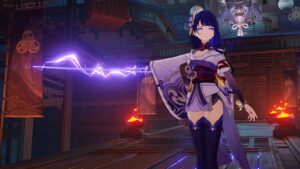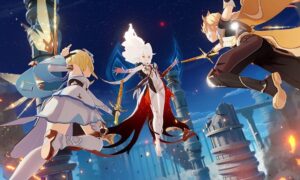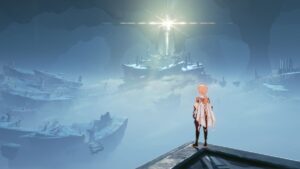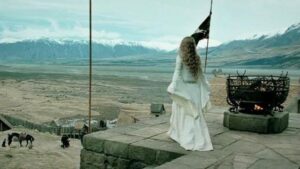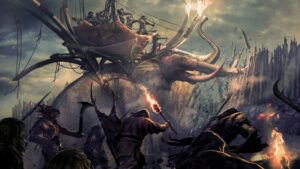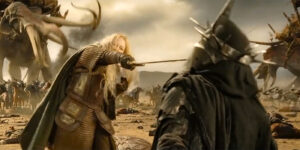POTENTIAL SPOILERS FOR THE RINGS OF POWER AHEAD!
In a new, minute-long, sneak peek at the second full-length trailer for Amazon’s The Lord Of The Rings: The Rings Of Power, everyone in Middle-earth is looking up to the skies in anticipation of something, be it an answer to their prayers or a reckoning for their misdeeds or divine punishment upon their enemies – but when a meteor actually streaks across the heavens, leaving a trail of blazing flame in its wake as it hurtles toward Wilderland (and straight into the midst of a peaceful nomadic community of Harfoots whose lives will be irrevocably altered by their encounter with the meteor), there’s no telling which of those it will be, or whether it’s something entirely different.

You might be wondering where in all of J.R.R. Tolkien’s writings does the author mention a meteor striking Middle-earth in the middle of the Second Age, and to that there really is no good answer. Off the top of my head, there’s one reference in The Silmarillion to the swords Anglachel and Anguirel being “made of iron that fell from heaven as a blazing star”, i.e. a meteorite, but one that fell during the First Age, and then there’s the mysterious Stone of Erech in Númenor (later transported by ship to Gondor) which “some believed…had fallen from the sky”. But everything we know about The Rings Of Power‘s “meteor” from leaks and previously released footage suggests that it’s a strange, disheveled man, and not a chunk of rock.
Middle-earth’s skies are conveniently crowded with minor deities and even a couple of stray Elves who could potentially take a tumble, but I feel like The Rings Of Power would be backing itself a corner by trying to insert guest appearances from the likes of, say, Eärendil the Mariner or even Tirion, god of the moon, into a story where neither of these characters had any relevance to begin with, because if they did it would have been a pretty big deal…like a really big deal…like the kind of momentous event that would have warranted at least a footnote in Tolkien’s Appendices to The Lord Of The Rings, I think (although I suppose I ought to note that the Hobbits of the Third Age did have a legend about the “Man in the Moon” coming down to earth one night to get wasted, so, uh, make of that what you will).
The prevailing theory among fans, of course, is that the “Meteor Man” is none other than Sauron, adopting a convincing disguise and putting on a show so he can slither back into Middle-earth after centuries of banishment in desolate lands – but I get the sense that Amazon only wants us to think that, to draw attention away from the other original characters in the sprawling ensemble cast who are just as likely to be Sauron (personally, I’m sticking by this theory, posed a few months back on Reddit by u/TheManFromFarAway, that the Meteor Man is Old Man Willow – specifically, the malicious spirit that will end up trapped in a willow-tree in the Old Forest and eventually become known as Old Man Willow).
What I really like about that theory is that Old Man Willow is only relevant to the Hobbits, so he could stay with the Hobbits (sorry, the Harfoots) for the course of the entire show and it wouldn’t break canon because Old Man Willow is a pretty minor character in the grand scheme of things. Him just being there wouldn’t necessarily cause any glaring plot-holes; at least none that come to mind. But regardless, everyone in Middle-earth saw something fall from the sky – and I’m assuming that while they’ll each have their own interpretation of what it means, it will be widely read as a sign of approaching upheaval, calamity, and changes both great and terrible. They wouldn’t be wrong to think that.
Most of the teaser is just a montage of several noteworthy characters looking up at the sky, stitched together to make it seem as if they’re all watching the meteor fall at the same moment – a few of them clearly are, but some, like Númenor’s Queen Tar-Míriel, the Dwarven prince Durin IV, and the Lady Galadriel, are just as obviously glancing upwards at other things, or at nothing in particular. When the meteor falls, presumably near the very end of episode one just before the cut to credits (I can already envision how it will play out in my head), I assume Galadriel will still be in Lindon, the realm of King Gil-galad. My guess is that in episode two, alarmed by the meteor, Gil-galad sends Galadriel and a crew of seafaring Elves west to Valinor to try and seek answers from the Valar regarding the meteor’s origins.
That, I think, is what we see in this teaser – Galadriel standing on the deck of a small ship carved in the shape of a swan, much like the one she and Elrond sailed into the Uttermost West at the end of the Third Age, with white seabirds spiraling around the mast. I’m also going to hazard a guess that this is the same ship we know for a fact gets wrecked during a storm at some point in the first two or three episodes, resulting in the tragic loss of the entire crew save for Galadriel and a human named Halbrand (whom I now believe is a stowaway trying to sneak into Valinor, which makes a lot of sense given what we know about his character). Of course, mortal men like Halbrand are strictly forbidden from setting foot in Valinor, which is probably the reason for the sudden storm and the failure of Galadriel’s mission.
The leaks, which mostly come from Fellowship Of Fans on YouTube (check out his channel if you haven’t already), indicate that no later than episode three, Galadriel and Halbrand wash up on the shores of Númenor, an island kingdom in the middle of the ocean separating Middle-earth and Valinor, inhabited by humans of unusually tall stature and great strength. Their queen, at the time this story opens, is Tar-Míriel – and yes, canonically, her cousin Ar-Pharazôn usurped the throne before she could ever take up the crown and scepter of Númenor, but The Rings Of Power is playing around with the timeline and giving her a bit more time to rule before that happens, which is actually…not a terrible idea? Hopefully, it allows us to feel the tragedy all the more deeply because by that point we’ll actually understand for ourselves why Tar-Míriel could have been a great leader, instead of having to take Tolkien’s word for it as is the case in the text.
Circling back around to Lindon (only because we know quite a lot about the Numenorean subplot in The Rings Of Power season one, and I’m afraid I’ll give too much away if I keep rambling on), it seems that Gil-galad wants to cover all of his bases and so puts his young herald Elrond in charge of an expedition eastward, perhaps to try and find the crash-site. We know that Elrond will end up in Khazad-dum as a guest of Durin IV and Disa, and he probably spends some time in Eregion with Celebrimbor as well (I can’t explain it, but I have this sneaking suspicion Celebrimbor will try to manipulate Elrond into working for him by reminding him of the debt Elrond owes to Celebrimbor’s family for saving his life as a child – long story, read The Silmarillion), but I haven’t heard any rumors regarding what happens to Elrond after that, whether he returns to Lindon or ventures further into the east of Middle-earth in search of the Meteor Man.

Meanwhile, far southeast of Lindon in a verdant region of Middle-earth soon to be burned unrecognizable by the coming of Sauron, a Silvan Elf named Arondir and village apothecary named Bronwyn – both original characters created for The Rings Of Power – grab for each other’s hand as they watch the meteor descend from the skies, dangerously close to where they’re standing. I’ve previously speculated that the village of Tirharad, where Bronwyn lives, and the ruins of the Elven settlement it’s built on, which used to belong to Arondir’s people, all exist on land that will one day become known as Mordor; around the same time that Bronwyn and Arondir, following in the footsteps of other star-crossed lovers before them, will probably die defending their homes from Sauron’s legions of orcs (that’s purely speculation on my part, not a spoiler, but come on…these two aren’t making it out of the show alive).
The meteor finally zips over Fangorn Forest before crashing in Wilderland, startling a couple of Ents who were just minding their own business – confirmation, if any was needed, that there will indeed be Ents in The Rings Of Power, although I’d recommend keeping your expectations fairly low if you’re going into season one hoping the Ents play a major role…or really, any role except as bystanders…in the narrative. Entwives, on the other hand, might have a little something to do if we ever get to visit their gardens in the south of Wilderland, but I’d be extremely surprised (delighted, mind you, but still surprised) if we got the chance in season one.
By an extraordinary coincidence, the kind that would make even Gandalf take notice, the meteor lands just a mile or two away from a group of Harfoots camping in the woods, and is there discovered by the most unlikely person imaginable: Elanor “Nori” Brandyfoot! We’ve talked at length about the identity of Meteor Man already, so there’s no need to rehash any of that, but Elanor is potentially even more interesting because she’s a hobbit, and Amazon is likely to do something important with her character. There’s one itty-bitty little problem, which is that neither she nor any of the Harfoots can do anything too important without breaking canon, or if they do, it must be done in secret and without anyone – specifically Sauron – ever finding out about it.
The reason for this is that Gandalf tells Frodo Baggins in The Lord Of The Rings that, until Sauron first heard the name of Baggins and The Shire from Gollum, the Dark Lord had “entirely overlooked the existence of hobbits”, or so Gandalf believed. One could argue that Gandalf was wrong, and, well, it wouldn’t be the first time, nor would it be entirely implausible in this case – Gandalf wasn’t actually around during the Second Age, having not yet taken a physical form, so he might not have been aware of everything that Sauron knew – and of course, if Sauron knew of hobbits but was mistakenly led to believe that he had killed all of the hobbits for whatever reason, that could work too, but all of these excuses kinda miss the point, which is that Sauron needs to have overlooked hobbits for a very simple thematic reason.
Sauron, gnawed incessantly by his envy of the gods and all of their creations in Middle-earth, seems to have always been hyper-aware of anything he perceived as greater than himself – people, places, inanimate objects – and if he couldn’t improve upon a thing further, as he did with the Rings of Power for probably the last time in his life, then he sought only to destroy it. Anything undeserving of his envy was undeserving of his rage or his attention in general, and that’s exactly why he lost the War of the Ring, because even after learning that a hobbit was in possession of the One Ring and was heading towards Mount Doom with the intention to destroy it, he was still convinced that Aragorn and the Elves were his real enemies, and that something as insignificant as a hobbit wasn’t worth guarding against.

So the only way I’ll accept Sauron learning about the existence of hobbits in The Rings Of Power, potentially even interacting with hobbits if he truly is the Meteor Man, is if we see how this delusion came about, with him immediately abandoning the hobbits once he realizes that he can’t use them to his own gain, even after all that Elanor and the community did for him. It would perhaps be poetic if a hobbit saved his life, seeing as a hobbit also took it away – both times without Sauron ever even registering it.
But now I want to know what you think about Meteor Man, who you think he is and when we’ll find out his true identity – will it be in season one of The Rings Of Power, or will we have to wait even longer? Could all of our questions be answered when the full-length trailer drops on July 14th? Share your own thoughts, theories, and opinions, in the comments below!

